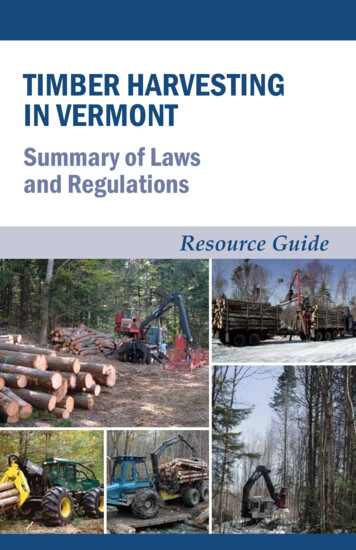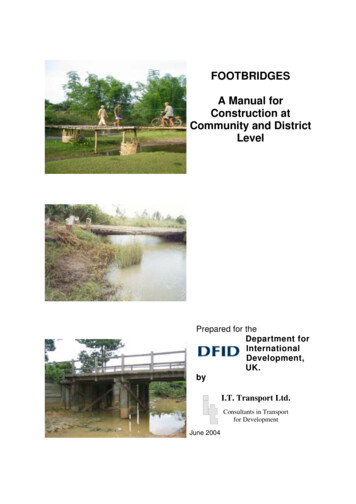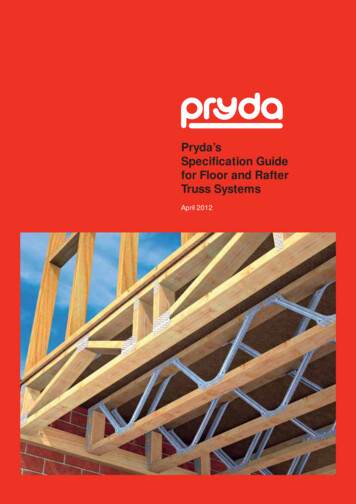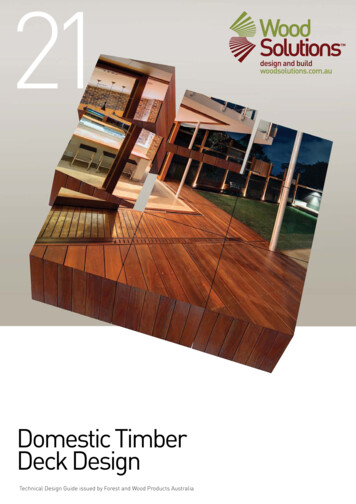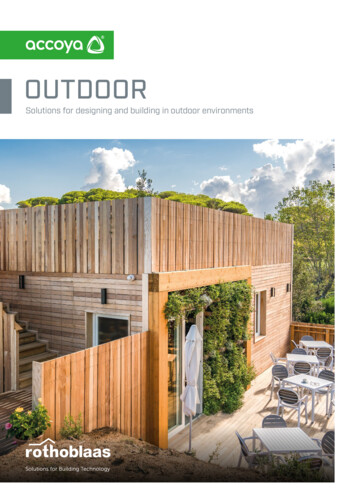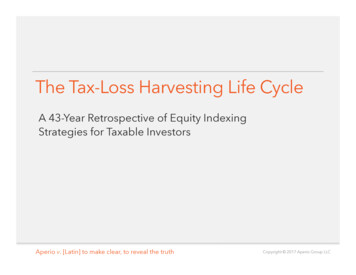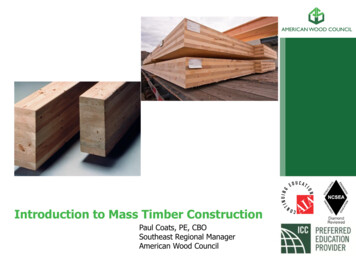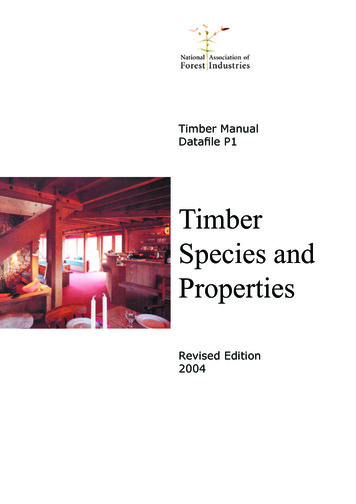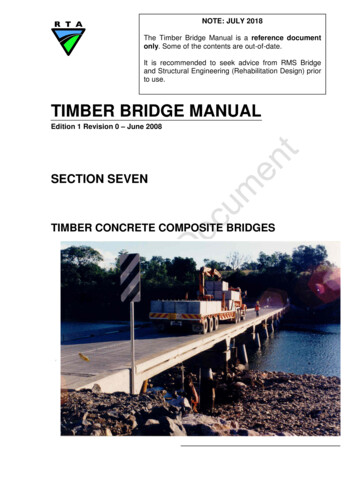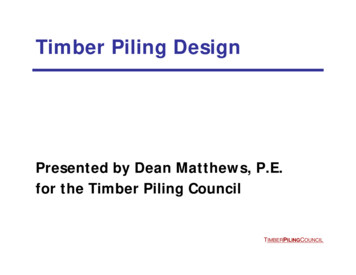
Transcription
3.1 TIMBER HARVESTING SYSTEMSBACKGROUNDChoosing the most appropriate timber harvesting system can meet management objectives andminimize environmental impact.A timber harvesting system is one of several combinations of equipment used for felling and extractingtimber. Every system requires (1) a mechanism for felling trees and (2) a mechanism for removingfelled trees or portions of felled trees to a roadside log landing for transportation to a mill. Matching theequipment to the site, implementing proper harvest layout, and hiring a skilled operator all contribute tosuccessful logging. A licensed forester and a certified logger can help choose the right system. Landownerschoosing to harvest timber on their own must decide if they have the time, skill, equipment, andknowledge to do so or if they wish to contract the services.OBJECTIVESelect a timber harvesting system appropriate to the site and landowner objectives.CONSIDERATIONSlFinancial return is often a factor when considering which harvesting system to use. Costsassociated with different logging methods vary and may affect the income received.lTime of year can influence equipment choice. Frozen winter conditions may be suitable to almostany system, while a summer or fall harvest may limit use of some equipment, particularly on siteswith wet soils.lGround conditions such as wet sites, rocky terrain, or steep slopes may limit use of theequipment.lThe size of the harvest area, tree density, and the size and value of the timber may limit thepracticality of using some harvest systems. Equipment should be able to fell and move timberefficiently to the landing. Equipment that is too small may struggle handling large timber anddamage the remaining trees. Skidding distances longer than half a mile may limit the feasibility ofsome equipment. Using equipment that is too large may result in higher levels of residual damagein tight stands of small timber. It may be inefficient to use large machines on lots smaller than 10acres.lThe quality and quantity of the timber and the expected products help determine the feasibilityof a method. Are there more high-quality sawlogs or more pulpwood? Will the tops be chipped?In a woodlot growing small, scattered, low-value trees, the cost of logging may be higher than thefinancial return. The ability to sort for multiple markets depends on the right mix of equipment,as well as the experience and skill of the operator.lSystems using the entire tree may result in an aesthetically pleasing appearance and may bedesirable on highly visible sites.lLayout of truck roads, landings and skid trails affects efficiency and differs for each harvestingsystem. Long skidding distances and limited landing size may also limit the choice of equipment.Mechanized systems tend towards high production, covering more ground more quickly thanconventional systems, making presale layout and sale supervision important.Good Forestry in the Granite StatePage 55
3.1: Timber Harvesting SystemslOperator skill plays the greatest role in determining success, regardless of the equipment chosen.A skilled operator reduces equipment impact, while an inexperienced one can do damage in ashort time.lThe environmental sensitivity of a woodlot may dictate which logging equipment is mostsuitable. Crossing wetlands, logging near cultural artifacts and threatened and endangered plants,scarifying soil to promote regeneration, or minimizing disturbance to advanced regeneration maybe some of the factors to consider. Implementing best management practices (BMPs), silviculturalprescriptions, and job layout for the equipment, then carefully closing out the sale will go a longway to achieving a successful timber harvest.lSafety is integral to all decision-making including who operates in the woodlot, what equipmentthey bring, and what steps they take to ensure safe operating procedures. Some equipmentprovides a much greater level of safety and control, allowing work to be conducted in hazardousconditions. Operators must take responsibility for ensuring that everyone in and around thelogging operation is safe at all times.Commonly Used Timber Harvesting SystemsThe following descriptions represent commonly used systems (but don’t represent every possiblecombination).lConventional logging—uses a chainsaw and cable skidder.lMechanized logging—uses a feller-buncher, grapple skidder or other auxiliary equipment such asa loader, delimber, slasher, and chipper. Whole-tree (biomass) harvesting is a form of mechanizedlogging that typically adds a chipper for processing whole trees into chips at the landing, a loaderto feed the chipper, and a trailer into which the chips are blown.lCut-to-length system—mechanized logging using a processor and forwarder combination.lOther systems include draft animals, tractors, and other machinesConventional LogginglFelling System - ChainsawThe chainsaw is the most common method for manually felling trees. A skilled chainsaw operatorcan fell trees directionally. Training in chainsaw use and maintenance is critical for safely fellingtrees.lExtraction System - Cable SkidderA cable skidder uses a winch, cable andchokers (chain) to gather and drag a load(hitch) of trees or logs. A cable skidderallows the operator to pull the cable to thetrees rather than driving the machine to eachtree. This allows for flexibility on uneventerrain. The cable-skidder operator must exitthe machine to attach each tree to the cable.The winch pulls the trees, butt first, to theskidder by reeling the cable over an arch.The arch raises the hitch off the ground,reducing the friction and impact to theground during the course of the skid.Page 56Cable SkidderGood Forestry in the Granite State
3.1: Timber Harvesting SystemslPros:! Allows large, valuable trees to be felled without damage.! Allows trees to be removed from sensitive and difficult locations.! Because trees are topped and limbed in the woods, reduces the size of the hitch, which in turnmay reduce residual stand damage. Tops left in the woods may reduce nutrient depletion onpoor sites.! May prove cost-effective, especially on small jobs.lCons:! Requires extreme physical exertion and exposure to adverse environmental conditions.! Leaves the chainsaw operator vulnerable to falling debris and chainsaw injury.! Is typically slower than a mechanized system.! May damage advanced regeneration more than mechanized systems.Mechanized LogginglFelling SystemFeller-bunchersA feller-buncher, or harvester, describes any number of machines that cut (fell) and gather andpile (bunch) trees. The machine either drives to the base of the tree or reaches to the tree witha boom (extending arm). It severs the tree, using either a circular saw or a chainsaw-type headwhich cuts the tree, or a shear which pinches the tree off. Shears have fallen out of favor for use inhigh-quality timber because they crush the tree’s fiber when the tree is severed.After felling, trees are piled into hitches in or along skid trails for removal to the landing bya skidder. Mechanized operations tend to be whole-tree operations, which remove the entiretree from the forest for processing at the landing. This requires the support of several pieces ofauxiliary equipment such as a loader, delimber, slasher and chipper. The loader moves productsaround the landing as trees are processed into logs and chips. The delimber removes branches,and the slasher cuts logs to length. Poor-quality stems and tops are run through the chipper tocreate biomass.3-wheeled HarvestersThe 3-wheeled harvesters are rubber tired and highly maneuverable and designed for smallerdiameter trees. Typically configured with a fixed shear head, they work well in tight stands and oneven terrain.4- and 6-wheeled HarvestersA felling machine with a fixed head mounted (typically) on a rubber-tired machine. The fixedhead harvester requires the operator to drive to the tree base to fell the tree.Tracked HarvesterThese tracked felling machines feature a cutting head mounted on a boom which reaches up to 20feet. This reach aids harvesting on rough and steep terrain. The boom also allows the machine toharvest and carry large-diameter trees, as well as to direct the felling, which protects the residualstand.Good Forestry in the Granite StatePage 57
3.1: Timber Harvesting SystemslExtraction System - Grapple SkidderA grapple skidder uses a grapple to bunch, hold and drag a load of trees or logs. The operatordoesn’t get out of the machine to assemble a load, improving efficiency and operator safety. Thegrapple raises the hitch off the ground, reducing the friction and impact to the ground during theskid. Because the grapple skidder requires the operator to drive to the felled trees, some machinesalso have a cable with which to pull trees.lPros:! The feller-buncher is able to carefully cut trees and lay them down where desired, protectingadvanced regeneration, residual trees, cultural resources, and sensitive sites.! Tracked machines may reduce soil compaction.! Self-leveling, track-mounted feller-bunchers aid harvesting on steep slopes.! Small feller-bunchers are maneuverable in tight stands.! Mechanized logging offers high production.! The operator remains in the cab of the machine.lCons:! May result in residual stand damage, as well as greater soil disturbance or compaction.! Smaller feller-bunchers may not be able to handle large trees.! Mechanized logging, particularly a whole-tree operation, requires larger landings and skidtrails.! Logs may be damaged from multiple handling, improper machine adjustment, or operatorinexperience.! Whole-tree harvesting may deplete soil nutrient levels on poor sites over time.lAuxiliary Harvesting EquipmentDelimberThe delimber takes the limbs off of the tree either by dragging the stem horizontally througha metal frame or by passing a metal arm down the length of the stem. The delimber is also anintegral part of the processing head on a cut-to-length processor.SlasherA slasher is a circular saw or chainsaw mounted on a steel frame. The stem is placed in the framehorizontally by a loader and cross-cut or bucked to length. The slasher allows for high-volumeprocessing of stems while protecting the operator in a cab.ChipperThe chipper used on a logging operation is capable of processing large, low-quality stems andbranches into chips. The resulting whole-tree chips (biomass) are used as fuel at wood-to-energypower plants. A flail chipper (chipper which removes the bark from the stem before chipping),can produce pulp-quality (clean) chips used in paper or wood-pellet manufacturing. The barkand other flail material can be used as fuel, mulch or matting on sensitive logging areas. Chips areblown into tractor-trailer vans for transport.Page 58Good Forestry in the Granite State
3.1: Timber Harvesting SystemsCut-to-Length SystemFelling System - ProcessorA tracked or rubber-tired machine witha computerized cutting head used to fell,delimb, and buck (cut into smaller lengths)trees at the stump. A processor combinedwith a forwarder is referred to as a cut-tolength system. The cut-to-length system isoften used on sensitive sites. The operatordoesn’t have to exit the machine to harvestand process trees. Limbs and tops areCut-to-Length Processortypically left in skid trails.l Extraction System - ForwarderA self-loading machine designed to carrytrees or parts of trees. The forwarder, whencombined with a processor forms a cut-tolength system. The forwarder may be usedin combination with a feller-buncher and/or a chainsaw. A forwarder is often preferredon sensitive sites, because it carries ratherthan drags the wood.l Pros:! The processor head allows the operatorto make decisions about the entire stemat the stump.Forwarder! The forwarder reduces ground impactbecause it carries logs rather than drags them.! The increased surface area of the forwarder’s wheels running over a mat of tree tops depositedon the trails protects the ground and distributes the weight of the loaded machine.! The logs may be cleaner, which some mills prefer.! The system allows for smaller landing sizes.! Processing tops and limbs in the forest may reduce nutrient depletion.! The operator remains in the cab of the machine.l Cons:! A cut-to-length system is expensive.! The processor may have difficulty with larger trees.! The processor head (rollers) can damage sawlogs.! Hand felling and delimbing may be required, especially with larger hardwood.! The system isn’t usually as productive as traditional mechanized logging and has a higheroverhead for equipment, which may result in slightly reduced stumpage prices.Other Skidding SystemsHorses, oxen and mules can be used to skid trees, though logging with animals is slow and not common.Operators need training and care to ensure the safety of the animals as well as the logger. Draft animalloggers have the option of drawing stems and loads on the ground or raising them with an arch, sled orforwarder. Stems or logs are often bunched on the ground by a single animal and then forwarded by ateam on an arch, sled or forwarder to minimize ground disturbance and residual stand damage. Draftanimal logging creates narrow skid trails and may be a feasible system for removing small volumes ofhigh-value trees from visually sensitive areas.lGood Forestry in the Granite StatePage 59
3.1: Timber Harvesting SystemsFarm tractors equipped with specifically designed winches may be used to skid smaller trees. Operatorsmust not exceed the limitations of the machine.Other machines used to skid logs included all-terrain vehicles (ATV), bulldozers and trucks. Eachmachine has its benefits and limitations. Care is needed with any non-traditional logging machine toensure the safety of the operators as well as those working in the vicinity.RECOMMENDED PRACTICES4 Get professional help. (See below for listings of licensed foresters and certified loggers).4 Choose an experienced logger. Visit several completed harvests to see what different equipmentand operators can do before making a final selection. Check references.4 Clarify expectations and objectives, and use a written contract.4 Lay out truck roads, landings and skid trails, and designate trees to cut (or leave) in advance.Tailor the layout to the harvest system selected (1) to reduce residual stand damage, soilcompaction and erosion, and (2) to preserve advanced regeneration, unique species and culturalartifacts.4 Time the harvest (1) to avoid wet or poor logging conditions and conflicting uses, and (2) tooptimize market conditions.4 Use BMPs for erosion control and to prevent sediment from entering streams or wetlands. Youcan find these guidelines in Best Management Practices for Erosion Control on Timber HarvestingOperations in New Hampshire, published by the N.H. Dept. of Resources and EconomicDevelopment, Division of Forests and Lands. Consult the latest version of this publication beforeharvesting timber.CROSS REFERENCES1.1 First Steps in Forest Management; 1.5 Staying Safe Working in the Woods; 2.3 Regeneration Methods;3.2 Logging Aesthetics; 3.3 Aesthetics of Skid Trails, Truck Roads and Landings; 3.4 Harvesting in HighUse Recreation Areas; 3.5 Soil Productivity; 4.1 Water Quality; 4.2 Wetlands; 4.3 Forest Managementin Riparian Areas; 4.4 Stream Crossings and Habitat; 5.4 Logging Damage; 6.3 Dead and Down WoodyDebris; 7.7 Steep Slopes and other chapters in the Sensitive Areas section; 8.1 Timber Products.ADDITIONAL INFORMATIONBennett, K. P. 2010. Directory of Licensed Foresters Providing Service to Forest Landowners in New Hampshire.UNH Cooperative Extension, Durham, N.H. http://extension.unh.edu/fwt/dir/index.cfm Accessed on August 2,2010.N.H. Dept. of Resources and Economic Development, Division of Forests and Lands. 2004. Best ManagementPractices for Erosion Control on Timber Harvesting Operations in New Hampshire. State of New /Resource000247 Rep266.pdf Accessed March 13, 2010.N.H. Timberland Owners Association. Certified Loggers List. New Hampshire Timber Harvesting Council’sProfessional Logger Program. http://www.nhtoa.org/ Accessed March 5, 2010.UNH Cooperative Extension. 2001. Safe Timber s/Resource001062 Rep1293.pdf Accessed on January 26, 2010.Smith, S. (ed). 2005. Best Management Practices for Forestry: Protecting New Hampshire’s Water Quality. UNHCooperative Extension, Durham N.H. Resource000248Rep267.pdf Accessed February 8, 2010.Smith, S. 2009. Guide to New Hampshire Timber Harvesting Laws. UNH Cooperative Extension, Durham, N.H.37 p.Virginia Tech Forestry. 2008. Timber Harvesting (Logging) Machines and dex.htm Accessed March 11, 2010.Page 60Good Forestry in the Granite State
Equipment should be able to fell and move timber efficiently to the landing. Equipment that is too small may struggle handling large timber and damage the remaining trees. Skidding distances longer than half a mile may limit the feasibility of some equipment. Using equipment that is too large may result in higher levels of residual damage
